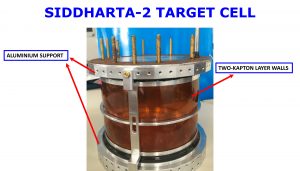SIDDHARTA-2 — The apparatus
1. The target cell
The SIDDHARTA-2 experimental target is a cylindrical cell having 144 mm diameter and 125 mm in height. The walls are made of a two-kapton layers 150 μm thick, placed on an high purity aluminium support [1,2]. The cell is filled with the target gas. A closed-cycle helium cooling system keeps the target cell at low temperatures up to 25 K, thus ensuring to aim a gas density which maximize the number of K–stopped in the target, and avoid the Stark mixing effect. The Stark effect mixes the kaonic atom states when the kaonic atom is crossing the Coulomb field of other target atoms [3]. Such effect increases the probability of nuclear absorption before that the K– reaches the 1s atomic level, thus decreasing the number of 2p→1s transitions performed by the K– in the target atom. Low densities avoid the Stark mixing effect, but also the number kaons stopped in the target. The cooling system is crucial to get the best deuterium density condition for the measurement. The target cell is placed inside a vacuum chamber evacuated below a pressure of 10-5 mbar to favor the cooling of the target cell and of the surrounding Silicon Drift Detectors (SDDs) whose aim is the measurement of the kaonic atoms x-ray transitions. The vacuum chamber is placed just above the Interaction Point of the DAΦNE collider, at the National Laboratories of Frascati (LNF-INFN), in Italy. The monochromatic, low-energy K– produced by the DAΦNE collider are degraded and then stopped in the target cell, favoring the formation of target kaonic atoms.

References
-
-
[1]. C. Curceanu et al., Kaonic atoms measurements at the DAΦNE collider: the SIDDHARTA-2 experiment, EPJ Web of Conferences 258, 07006 (2022).
-
[2]. L. De Paolis et al., Trigger rejection factor in the first kaonic helium run with the complete SIDDHARTA-2 setup, EPJ Web of Conferences 270, 00028 (2022).
-
[3]. J. Zmeskal, From kaonic atoms to kaonic nuclei: A search for antikaon-mediated bound nuclear systems, Prog. Part. Nucl. Phys. 61, 512 (2008).
-
[4]. M. Tuchler et al., Main Features of the SIDDHARTA-2 Apparatus for Kaonic Deuterium X-Ray Measurements, EPJ Web of Conferences 262, 01016 (2022).
- [5]. F. Napolitano et al., Kaonic Atoms at the DAΦNE Collider with the SIDDHARTA-2 Experiment, Physica Scripta 97, 8 (2022).
-
